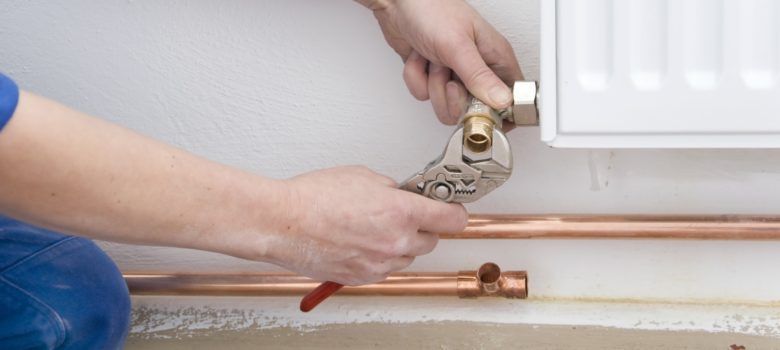
Since the passing of The Beast From The East, inefficient radiators have become a pretty big concern for homeowners, mostly due to the cold temperatures making their lack of functionality more noticeable.
Not only does this drastically affect the thermal comfort of your home, but inefficient radiators also lead to longer running times and therefore higher energy bills. So, we put together a bit of a self-help guide for those who are struggling with their radiators!
My radiators are warm at the bottom but cold at the top…
This is actually a really common problem and is very simple to solve. If your radiators are warm at the bottom but cold at the top this generally indicates that there is trapped air within the radiator. This often occurs because of a build-up of hydrogen, or for non-combi systems if you have an open tank in your loft for an immersion heater, or even if you’ve recently had a new central heating system installed with the pump above the supply pipe – this can increase the air intake.
The radiators that will most likely need bleeding the most often are the ones at the top of the house (so check your bedrooms, although apparently people sleep better in a cooler room) because air rises.
How do I bleed my radiators?
- Turn off your central heating and let it cool down. You need to do this so that a) you won’t be scolded by hot water and b) you’ll be letting out the optimal amount of air, because water expands when it is hot, therefore cold water will take up less space and allow for more air to escape.
- Find your radiator valve key, which is probably at the bottom of your household junk drawer (wherever it is, you should have one but you can buy them cheap if necessary!).
- Insert the (probably dusty) key into the valve on the top of the radiator while holding a rag underneath it to catch any escaping fluid.
- Turn the key slightly until you hear the sweet hissing sound of escaping air. Depending on how much trapped air is in your radiators, this could go on for a while – but be prepared to turn it quickly again when the air runs out, because water will rapidly follow!
- Bleed all the radiators in your house then switch your heating back on – you’ll need to assess whether there is any more trapped air, as the air moves around the system and could return to the same radiator from a different area of the house. If this is the case, start the whole process again!
My radiators are warm at the top and cold at the bottom…
Unfortunately if this is the case then you have a bigger job on your hands. Radiators that are warm at the top and cold at the bottom generally means that they have a layer of gunk at the bottom which is stopping it from getting properly hot. This effectively means that you’ll have to clean out your radiators, which you can do yourself if you’re a DIY kind of person. You also have the option of paying someone to do it for you by power flushing – this would generally cost a couple of hundred quid.
To clean out your radiators they need to be removed from the wall and the plumbing in order to rinse them through. Here’s a very basic rundown on how to do it:
- Turn off your central heating. When you remove the radiator from the wall, water will gush out and you certainly don’t want that to be hot water. So make sure the radiators are cold and the heating has been off a while.
- Be ready with old towels and washing up bowls/pans to catch the escaping water. You may need to get a couple of friends to help you out, or rope in the kids to hold the pots and pans at the ready…
- Turn the valves at both ends off. You should be able to turn the thermostatic valve (temperature valve) off with your hands by twisting it, but the lockshield valve you may need a wrench.
- Loosen the nuts that connect the thermostatic valve to the radiator. At this point, dirty water will probably come flooding out, so watch out for the cream carpets!
- Turn the nut on the lockshield valve and the radiator should be removable from the wall.
- Carry the radiator outside and attach a hosepipe to one of the valves to let the running water flush the radiator out. Once you’ve done this, re-attach it to the wall.
My radiators are cold all over
First thing’s first, check that your boiler/central heating is switched on!
If everything’s on but your radiator is still cold, you will need to establish whether it’s just one radiator that isn’t working or whether there’s a fault in the system. To do this, switch off all the radiators in your house except the cold one and check to see whether it heats up. If it does, switch on all the others one by one and identify if any other radiators are cold/need bleeding.
Check that your valves are open; if you have a thermostatic valve then just to be sure you may want to double check that it’s switched on! If it is switched on then you will need to check whether your thermostatic valve is working because these can sometimes seize up.
To check if it’s working, you’ll have to take the top of the valve off and check that the pin is moving up and down; if not, give it a tap and see if that fixes it. If it still won’t heat up after all of this, then you may need to replace the valve and/or call in a professional!
If you’re interested in getting a new boiler then try our partners over at Heatable, who offer finance options starting at only £10.28 a month.
We hope this has given you a few ideas as to how you can solve your inefficient radiator problems. It’s such a bore to deal with but so worth it when you think about how much money you will save just from having an efficient heating system.
Think we missed something? Do you have a different opinion?
Comment below to get your voice heard…













No Comments yet! Be the first one.